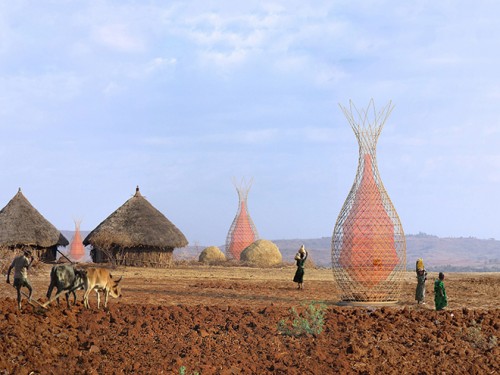Towers in Ethiopia that harvest clean water from thin air
Share
Explore Our Galleries
Breaking News!
Today's news and culture by Black and other reporters in the Black and mainstream media.
Ways to Support ABHM?
From Africa Speaks for Africa

These towers, designed by an Italian architect, collect clean water from dew and fog.
It’s one of the most precious resources on Earth, but its importance seems forgotten in the western world where its ease of access is often instantaneous. But for 768 million people worldwide, it’s a daily struggle to find safe water, and in result, 1,400 children under the age of five die from water-based diseases every day.
Inspired to offer solution to this issue in a creative way, designer Arturo Vittori invented stunning water towers that can harvest atmospheric water vapor from the air. The nearly 30-foot tall WarkaWater towers can collect over 25 gallons of portable water per day, and are comprised of two sections. The first is a semi-rigid exoskeleton built by tying stalks of juncus or bamboo together; the second, an internal plastic mesh similar to the bags oranges are packed in. The nylon and polypropylene fibers act as a scaffold for condensation, and once droplets of dew form, are funneled by the mesh into a basin at the base of the structure.

Women, who are usually the ones responsible for hauling water, carry on average 45 pounds of water at a time.
The crisis of water shortage caught Vittori’s attention while traveling through Ethiopia. “There, people live in a beautiful natural environment but often without running water, electricity, a toilet, or a shower,” he says. It’s common for women and children to walk miles to worm-filled ponds which are contaminated with human waste. There, they collect water in trashed plastic containers or dried gourds, then carry the heavy load on treacherous roads back to their homes. This is a process which takes hours and endangers the children by exposing them to dangerous illnesses. It also takes them away from school – ensuring that a cycle of poverty repeats.
Read the full article at Awareness.Com
Find more Breaking News here.











Comments Are Welcome
Note: We moderate submissions in order to create a space for meaningful dialogue, a space where museum visitors – adults and youth –– can exchange informed, thoughtful, and relevant comments that add value to our exhibits.
Racial slurs, personal attacks, obscenity, profanity, and SHOUTING do not meet the above standard. Such comments are posted in the exhibit Hateful Speech. Commercial promotions, impersonations, and incoherent comments likewise fail to meet our goals, so will not be posted. Submissions longer than 120 words will be shortened.
See our full Comments Policy here.